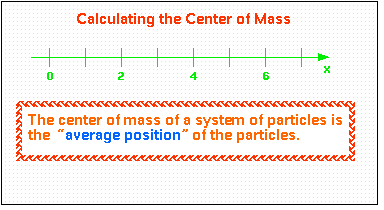 Center of Mass in One Dimension
Center of Mass in One Dimension
 Center of Mass in One Dimension
Center of Mass in One Dimension
The animation at right will hopefully convince you that the center of mass of a system of n particles (of constant mass) is given by:
where xcm is the position of the center of mass, m1 is the mass of the first particle, x1 is the position of the first particle, etc.
Starting with the center of mass equation, it is easy to show that the velocity of the center of mass of a system of n particles, vcm, is:
where v1 is the velocity of the first particle, v2 is the velocity of the second particle, etc., and M is the total mass of the system.
Aside from being very handy when dealing with both inelastic and elastic collisions, what is this equation trying to tell us? Rearanging the last result gives:
On the right side of this equation, m1v1 is the momentum of particle 1, m2v2 is the momentum of particle 2, etc., so the right side of the equation is the total momentum of the system of particles. Looking at the left side of the equation, Mvcm would be the momentum of the center of mass of the system - if we assume that all of the mass of the system is located at the system's center of mass. In other words, the equations above are saying that:
In the same way, we can derive an equation for the acceleration of the center of mass, acm:
where acm is the acceleration of the center of mass of the system, and a1 is the acceleration of particle 1, etc. Does this equation have anything to say? Well, multiplying both sides by M gives:
Now, m1a1 is the net force on particle 1 (Newton's Second Law), m2a2 is the net force on particle 2, etc., so the right side is the net force on the system of n particles. The left side of the equation is the net force on the center of mass of the system if all of the mass of the system is located at the system's center of mass. So,
last update February 5, 2010 by JL Stanbrough